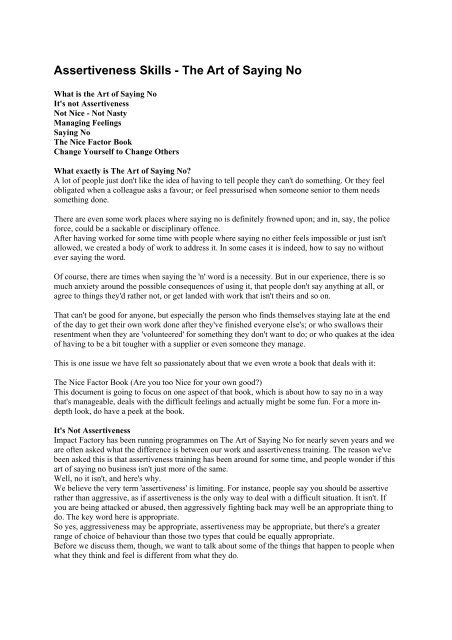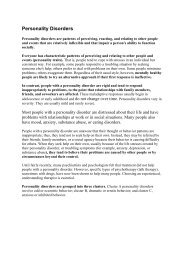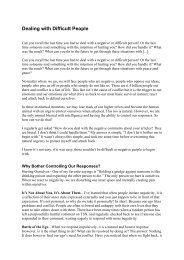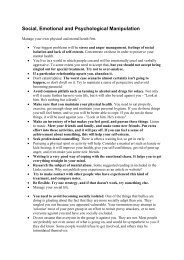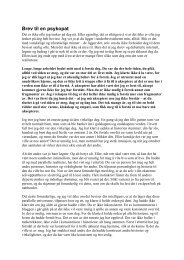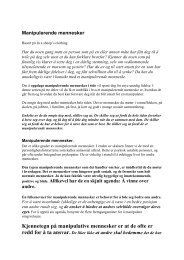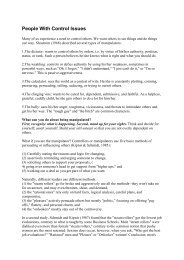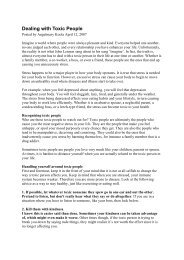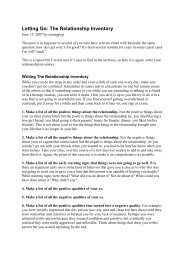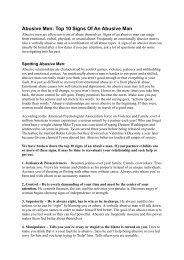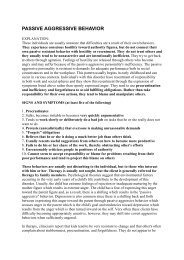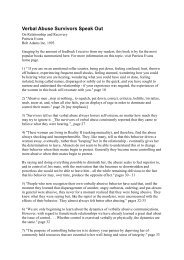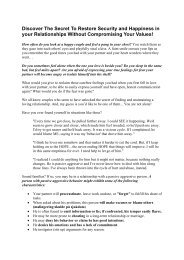Assertiveness Skills 1
Assertiveness Skills 1
Assertiveness Skills 1
Create successful ePaper yourself
Turn your PDF publications into a flip-book with our unique Google optimized e-Paper software.
<strong>Assertiveness</strong> <strong>Skills</strong> - The Art of Saying NoWhat is the Art of Saying NoIt's not <strong>Assertiveness</strong>Not Nice - Not NastyManaging FeelingsSaying NoThe Nice Factor BookChange Yourself to Change OthersWhat exactly is The Art of Saying No?A lot of people just don't like the idea of having to tell people they can't do something. Or they feelobligated when a colleague asks a favour; or feel pressurised when someone senior to them needssomething done.There are even some work places where saying no is definitely frowned upon; and in, say, the policeforce, could be a sackable or disciplinary offence.After having worked for some time with people where saying no either feels impossible or just isn'tallowed, we created a body of work to address it. In some cases it is indeed, how to say no withoutever saying the word.Of course, there are times when saying the 'n' word is a necessity. But in our experience, there is somuch anxiety around the possible consequences of using it, that people don't say anything at all, oragree to things they'd rather not, or get landed with work that isn't theirs and so on.That can't be good for anyone, but especially the person who finds themselves staying late at the endof the day to get their own work done after they've finished everyone else's; or who swallows theirresentment when they are 'volunteered' for something they don't want to do; or who quakes at the ideaof having to be a bit tougher with a supplier or even someone they manage.This is one issue we have felt so passionately about that we even wrote a book that deals with it:The Nice Factor Book (Are you too Nice for your own good?)This document is going to focus on one aspect of that book, which is about how to say no in a waythat's manageable, deals with the difficult feelings and actually might be some fun. For a more indepthlook, do have a peek at the book.It's Not <strong>Assertiveness</strong>Impact Factory has been running programmes on The Art of Saying No for nearly seven years and weare often asked what the difference is between our work and assertiveness training. The reason we'vebeen asked this is that assertiveness training has been around for some time, and people wonder if thisart of saying no business isn't just more of the same.Well, no it isn't, and here's why.We believe the very term 'assertiveness' is limiting. For instance, people say you should be assertiverather than aggressive, as if assertiveness is the only way to deal with a difficult situation. It isn't. Ifyou are being attacked or abused, then aggressively fighting back may well be an appropriate thing todo. The key word here is appropriate.So yes, aggressiveness may be appropriate, assertiveness may be appropriate, but there's a greaterrange of choice of behaviour than those two types that could be equally appropriate.Before we discuss them, though, we want to talk about some of the things that happen to people whenwhat they think and feel is different from what they do.
Many 'unassertive' people recognise that their pattern of behaviour is to be nice or compliant for farlonger than they really want to until they reach the point of no longer being able to hold it in; then theyexplode nastily and inappropriately all over whoever happens to be around.There are three ways this 'explosion' can happen. The first is that the rage happens inside the head andremains unexpressed. The second is that it is inappropriately expressed, and someone not involved,like a work colleague or secretary or even a bus conductor, becomes the recipient. The third isproperly directed at the 'offending party' but is out of all proportion to the probably small, butnonetheless final-straw-event that unleashes it.Not Nice Not NastyThis leaves people with the impression that there are only two states or behaviours they can do: Niceor Nasty. When, in fact, they have forgotten a whole range of behaviour that lies between Nice andNasty that can be termed Not-Nice (or even Not-Nasty).What we've seen with assertiveness, is that it is often seen as a single form of behaviour: just say no,stand your ground, be a broken record - all quite difficult if you are truly unassertive, or in our jargon -simply too nice for your own good. The concept of asserting yourself, (getting your voice heard, beingunderstood, being taken into account, getting your own way) needs to be broadened to include allforms of behaviour. It can include humour, submission, irresponsibility, manipulation, playfulness,aggressiveness, etc.The key point here is that the behaviour - nice, not-nice, nasty - is chosen. We emphasise the wordkey, because until people are able to choose behaviour that's free from the limiting effects of their fearof possible consequences, they will not be able to act no matter how well they are taught to beassertive. They will still feel overwhelmed in difficult situations.Managing FeelingsIt needs to be acknowledged that the strong feelings associated with changing behaviour are real andvalid. Once people do that, then these (usually difficult) feelings can be looked upon as a good thing, asign that something new is happening. At this point people can start to 'choose' to have these feelingsrather than having to endure them or trying to pretend they are not happening.The idea of choice is very important. If people feel they have real choice about how they behave, theystart to realise that it can be OK to put up with something they don't like. They can choose it becausethey want to; it is to their advantage. They then avoid the disempowering tyranny of always having toassert themselves. (Which is almost as bad as feeling you always have to be compliant or nice.)Many people think that in order to be assertive, you need to ignore what you are feeling and just 'standyour ground'. In fact, you ignore those feelings at your peril.Often the magnitude of peoples' feelings is way out of proportion to what the situation warrants. Theymay well reflect a previous difficult event more accurately. But because that previous difficulty was sodifficult, it feels as though every similar situation will be the same.It is only by beginning to experience and understand how crippling these feelings can be that peoplecan start to do anything about changing their behaviour. Many people know what they could say; theyknow what they could do. Most 'unassertive' people have conversations in their heads about how toresolve a conflict they're in; but still, their mouths say 'yes', while their heads say 'no'. Knowing whatto do or say is not the issue here.Therefore, in looking at practising 'the art of saying no', it is wise to broaden the brief to so that it isn'tabout becoming more assertive; rather it's about changing your behaviour to fit the circumstances.While in many circumstances assertiveness can be a straight jacket of it's own (often creatingresistance and resentment), the full lexicon of behaviour can be freeing, because there is choice in thematter. Using charm, humour, telling the truth or even deliberate manipulation, may well get you whatyou want without having to attempt behaviour that may go against your personality.If you add a dash of fun or mischief, The Art of Saying No becomes a doable prospect, rather thananother difficult mountain to climb.Saying NoHere are some pointers of what could make it easier to say 'no'.
If you're saying something serious, notice whether you smile or not. Smiling gives a mixed messageand weakens the impact of what you're saying.If someone comes over to your desk and you want to appear more in charge, stand up. This also workswhen you're on the phone. Standing puts you on even eye level and creates a psychological advantage.If someone sits down and starts talking to you about what they want, avoid encouraging bodylanguage, such as nods and ahas. Keep your body language as still as possible.Avoid asking questions that would indicate you're interested (such as, 'When do you need it by?' or'Does it really have to be done by this afternoon?' etc.)It's all right to interrupt! A favourite technique of ours is to say something along the lines of, 'I'mreally sorry; I'm going to interrupt you.' Then use whatever tool fits the situation. If you let someonehave their whole say without interrupting, they could get the impression you're interested and willing.All the while they get no message to the contrary, they will think you're on board with their plan (toget you to do whatever...)Pre-empt. As soon as you see someone bearing down on you (and your heart sinks because you knowthey're going to ask for something), let them know you know: 'Hi there! I know what you want. You'regoing to ask me to finish the Henderson report. Wish I could help you out, but I just can't.'Pre-empt two. Meetings are a great place to get landed with work you don't want. You can see itcoming. So to avoid the inevitable, pre-empt, 'I need to let everyone know right at the top, that I can'tfit anything else into my schedule for the next two weeks (or whatever).'Any of these little tips can help you feel more confident and will support your new behaviour. Forthat's what this is: If you're someone whom others know they can take advantage (they may not evenbe doing it on purpose, you're just an easy mark!) you need to indicate by what you do that things havechanged.Here's an Analogy we use in The Nice Factor Book:Let's say you're a burglar. There's a row of identical houses and you're thinking of having a go at fiveof them. The first house has a Yale lock on the front door. The second house has a Yale and a Chubblock on the front door. The third house has a Yale and a Chubb lock on the front door and bars on thewindow. The fourth house has a Yale and a Chubb lock on the front door, bars on the window andburglar alarm. The fifth house has a Yale and a Chubb lock on the front door, bars on the window, aburglar alarm and a Rottweiler.Which would you burgle?When you make it easy for other people, they will naturally keep coming back. By learning moreeffective ways of saying 'no' you make it harder for others to expect you to do what they want withouttaking into account what's going on for you. You become more burglar-proof.Changing Others by Changing YourselfA lot of us wish that the person we are in conflict with, or feel intimidated by, would change. Theneverything would be all right. We've all heard this from a colleague, friend, partner and even said itourselves: 'If only he'd listen to me, then I wouldn't be so frightened.' 'If only she'd stop complainingabout my work, I'd be much happier.''If only' puts the onus on the other person to change how and who they are and makes themresponsible for how we feel. By using some of the tools outlined above, people can get a sense ofbeing in charge of situations, rather than being victims to what other people want.It does seem to be part of human nature to blame others when things go wrong in our lives, or whenwe're feeling hard done by. If you take away the 'if only' excuse you also take away the need to blameand make the other person wrong. It's also rather wonderful to think that rather than waiting forsomeone else to change to make things all right, we all have the ability to take charge of mostsituations and make them all right for ourselves.What also makes it easier is that we all just have to get better at 'the art of saying no'; none of us has tochange our whole personalities to create a more satisfying outcome!


